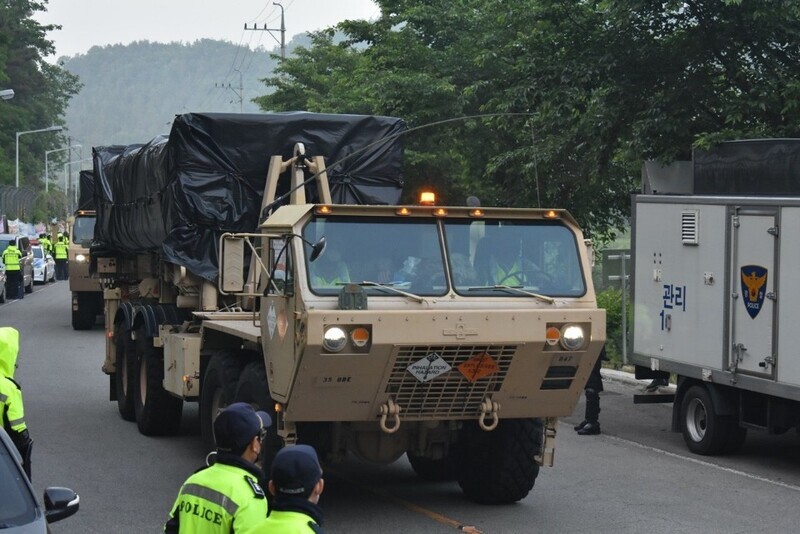hankyoreh
Links to other country sites 다른 나라 사이트 링크
S. Korean defense minister says Korean military conducted joint missile defense exercises with US

On June 10, Minister of National Defense Jeong Kyeong-doo announced that South Korean and US military authorities had conducted joint missile defense exercises. His remarks are now showing signs of reigniting the debate over South Korea’s incorporation into the US-led missile defense framework.
Speaking in reference to the South Korea-US allied defense posture at a meeting of major armed forces commanders at the Ministry of National Defense (MND) complex that day, Jeong said the two sides had “conducted a joint South Korea-US Air Force combat readiness posture drill and missile defense system integration exercise, as planned in the first half of this year.”
Joint missile defense system integration exercise made public for first time
While South Korea, the US, and Japan have disclosed a number of times in the past when they have conducted warning exercises involving the deployment of naval Aegis vessels to exchange North Korean missile detection and tracking information, this is the first time a South Korea-US missile defense system integration exercise has been made public. The exercises have reportedly been conducted on a regular basis for the past several years.
Military authorities were emphatic in stressing that the missile defense system integration exercise was merely a drill to share missile information between the two sides under a hypothetical North Korean missile launch scenario, and that it had nothing to do with South Korea being incorporated into the US-led missile defense framework. They explained that while the two sides share data on the flight positions, altitude, and speed of North Korean missiles that have been launched, each of them has its own means of actual missile interception -- Patriot missiles in the South Korean military’s case, Patriot missile and the Terminal High Altitude Area Defense (THAAD) system in the US’.

The sharing of missile information is reportedly taking place through an interlinked system between the South Korean military’s ballistic missile command and control center (AMD-cell) and US Forces Korea’s missile defense operation and control center (TMD-cell). But with the USFK operation and control center also linked to US Forces Japan’s missile defense system through the US Indo-Pacific Command, some observers are maintaining that this translates into an effective linkage with the Japan Self-Defense Forces’ missile defense system too. On this basis, they are suggesting that South Korea’s missile defense system is functioning as a lower-level system within the US’ missile defense framework.
In response, a South Korean military official said, “It’s mere speculation to interpret the simple sharing of information as meaning we are being incorporated into US-led missile defense.”
By Park Byong-su, senior staff writer
Please direct comments or questions to [english@hani.co.kr]

Editorial・opinion
![[Column] Season 2 of special prosecutor probe may be coming to Korea soon [Column] Season 2 of special prosecutor probe may be coming to Korea soon](https://flexible.img.hani.co.kr/flexible/normal/500/300/imgdb/original/2024/0426/3317141030699447.jpg) [Column] Season 2 of special prosecutor probe may be coming to Korea soon
[Column] Season 2 of special prosecutor probe may be coming to Korea soon![[Column] Park Geun-hye déjà vu in Yoon Suk-yeol [Column] Park Geun-hye déjà vu in Yoon Suk-yeol](https://flexible.img.hani.co.kr/flexible/normal/500/300/imgdb/original/2024/0424/651713945113788.jpg) [Column] Park Geun-hye déjà vu in Yoon Suk-yeol
[Column] Park Geun-hye déjà vu in Yoon Suk-yeol- [Editorial] New weight of N. Korea’s nuclear threats makes dialogue all the more urgent
- [Guest essay] The real reason Korea’s new right wants to dub Rhee a founding father
- [Column] ‘Choson’: Is it time we start referring to N. Korea in its own terms?
- [Editorial] Japan’s rewriting of history with Korea has gone too far
- [Column] The president’s questionable capacity for dialogue
- [Column] Are chaebol firms just pizza pies for families to divvy up as they please?
- [Column] Has Korea, too, crossed the Rubicon on China?
- [Correspondent’s column] In Japan’s alliance with US, echoes of its past alliances with UK
Most viewed articles
- 1Is Japan about to snatch control of Line messenger from Korea’s Naver?
- 2[News analysis] Using lure of fame, K-entertainment agency bigwigs sexually prey on young trainees
- 3[Column] Park Geun-hye déjà vu in Yoon Suk-yeol
- 4Will NewJeans end up collateral damage in internal feud at K-pop juggernaut Hybe?
- 5‘We must say no’: Seoul defense chief on Korean, USFK involvement in hypothetical Taiwan crisis
- 6[Column] The clock is ticking for Korea’s first lady
- 7[Column] Season 2 of special prosecutor probe may be coming to Korea soon
- 8Korea’s 1.3% growth in Q1 signals ‘textbook’ return to growth, says government
- 9Division commander ordered troops to enter raging flood waters before Marine died, survivor says
- 10Report reveals toxic pollution at numerous USFK bases